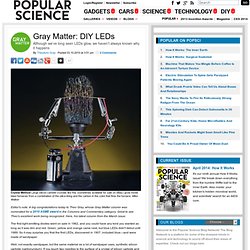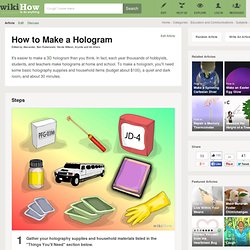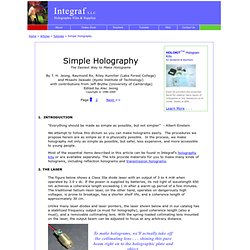

How to Build a Wiremap. The Wiremap is a project that builds digital 3d objects in real 3d space. To create digital 3d objects in real 3d space, a projector is placed in front of a custom designed projection surface made up of an array of vertical wires. If you'd like to learn more about the project in general, you can do so at the Wiremap website. This instructable will show you how to build your own Wiremap from scratch. Before we begin - let's just make sure that your computer system will run the programs that I've built. For windows users, download the following: For mac & linux, download the following: go to and download the program.
Windows - open calib_64 -> application.windows -> calib_64.exe. Other OS - open calib_64.pde with processing. Press escape to exit the program. The Double Helix -a DNA model with lights. Make Your Own: Black Hole Fabricator!! Faraday Rotation (EPIC!) This project recreates Faraday's 1845 experiment that revealed the fundamental nature of light: electromagnetic waves.

History: • In 1845, Michael Faraday used a powerful electromagnet to rotate the polarization of a beam of light, unifying electromagnetic force with light in one of the most elegant and seminal experiments ever. • Two decades later, James Maxwell confirmed this with his classical electromagnetic equations which showed that light is actually an electromagnetic wave. Gray Matter: DIY LEDs. Editor's note: A big congratulations today to Theo Gray, whose Gray Matter column was nominated for a 2010 ASME award in the Columns and Commentary category.

Great to see Theo's excellent work being recognized. Here, his latest column from the March issue: The first light-emitting diodes went on sale in 1962, and you could have any kind you wanted as long as it was dim and red. Green, yellow and orange came next, but blue LEDs didn't debut until 1989. Amazing Lasers! - Cheapy Lighter Laser Burner! How to Make a Hologram. Edit Article Edited by Alecander, Ben Rubenstein, Nicole Willson, Krystle and 44 others It's easier to make a 3D hologram than you think.

In fact, each year thousands of hobbyists, students, and teachers make holograms at home and school. To make a hologram, you'll need some basic holography supplies and household items (budget about $100), a quiet and dark room, and about 30 minutes. Ad Steps 1Gather your holography supplies and household materials listed in the "Things You'll Need" section below.
Lasers. 3D Scanner. How To Make A Hologram. The word hologram comes from Greek, with holos meaning whole and graphe meaning writing.

A hologram is an advanced form of photography that allows an image to be recorded in three dimensions, in fact a recording of an interference pattern made by the interaction of two beams of light. If two stones are dropped into water, waves radiate from the points of impact. Where the two sets of waves meet, the waves appear to pass through each other; however, where a crest of one wave coincides with a crest of the other wave, an extra high crest will form. Similarly, two troughs coinciding will form an extra low trough. How to Make Holograms. "Everything should be made as simple as possible, but not simpler” - Albert Einstein We attempt to follow this dictum so you can make holograms easily.

The procedures we propose herein are as simple as it is physically possible. In the process, we make holography not only as simple as possible, but safer, less expensive, and more accessible to young people. Most of the essential items described in this article can be found in Integraf's holography kits or are available separately. The kits provide materials for you to make many kinds of holograms, including reflection holograms and transmission holograms. The figure below shows a Class IIIa diode laser with an output of 3 to 4 mW when operated by 3.0 v dc. An excellent support for such a small laser is a wooden clothespin, as shown below. The wooden clothespin offers another advantage. The “white light reflection hologram” is the simplest to make. Holography. Two photographs of a single hologram taken from different viewpoints The holographic recording itself is not an image; it consists of an apparently random structure of either varying intensity, density or profile.

Overview and history[edit] The Hungarian-British physicist Dennis Gabor (in Hungarian: Gábor Dénes),[1][2] was awarded the Nobel Prize in Physics in 1971 "for his invention and development of the holographic method".[3] His work, done in the late 1940s, built on pioneering work in the field of X-ray microscopy by other scientists including Mieczysław Wolfke in 1920 and WL Bragg in 1939.[4] The discovery was an unexpected result of research into improving electron microscopes at the British Thomson-Houston (BTH) Company in Rugby, England, and the company filed a patent in December 1947 (patent GB685286). Several types of holograms can be made. Holograms can also be used to store, retrieve, and process information optically.[18] How holography works[edit] Fantastic 3D Visualization Wiremap. LED.